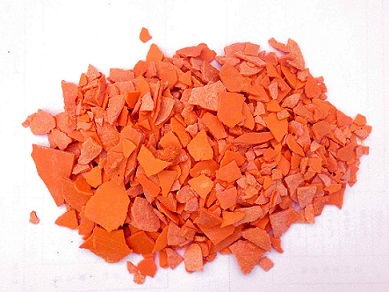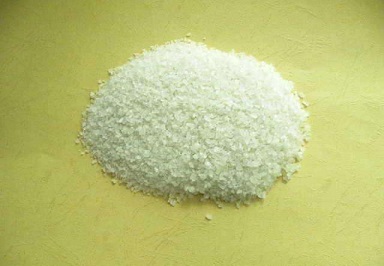1. The role of sodium sulfide in mineral processing
Sodium sulfide (Na2S) is a commonly used agent in the flotation of sulfide ores. Its functions mainly include the following three aspects:

1. Sodium sulfide is an inhibitor of most sulfide minerals
When used in large amounts, it can inhibit the vast majority of sulfide ores. The decreasing order in which it inhibits sulfide minerals is roughly: galena, sphalerite, chalcopyrite, bornite, covellite, pyrite, and chalcocite. Since molybdenite is naturally very buoyant, sodium sulfide cannot inhibit it. Taking advantage of this, when flotating molybdenite, Na2S can be used to suppress other sulfide ores.
2. Sodium sulfide is a sulfiding agent for non-ferrous metal oxide ores
Non-ferrous metal oxide ores cannot be directly collected by xanthate. However, if sodium sulfide is added to react with non-ferrous metal oxidized minerals before xanthate flotation, a thin film of sulfide minerals can be produced on the surface of the mineral, and the xanthate can be collected. This effect of sodium sulfide is called sulfidation, so it can be used as a sulfiding agent for non-ferrous metal oxide ores.
After the interaction between cerusite and sodium sulfide, the surface color changes from white to dark. After the interaction between malachite and sodium sulfide, the surface color changed from green to dark black, indicating that after sulfide, a sulfide film different from the mineral was formed on the surface of these two minerals.
3. Sodium sulfide is a deagent for sulfide ore mixed concentrates
When sodium sulfide is used in large amounts, it can decompose xanthate collectors on the surface of adsorbed minerals. Therefore, sodium sulfide can be used as a dechemical agent before the separation of mixed concentrates. For example, before sorting lead-zinc mixed concentrate or copper-lead mixed concentrate, the slurry can be concentrated, a large amount of sodium sulfide can be added to remove the chemicals, then washed, fresh water can be added again to mix the slurry, and then separation and flotation can be carried out.
In addition to the above three main functions, because sodium sulfide can form insoluble sulfide precipitation with many metal ions, sodium sulfide can also eliminate certain ions in the slurry that are harmful to flotation.
2. Production process of sodium sulfide
A granular sodium sulfide production process, including raw materials – calcination – hot melt – clarification and mud washing – chemical impurity removal – precipitation – evaporation concentration and other processes, and the concentrated sodium sulfide solution is stored in a reactor or agitator , the sodium sulfide content is ≥60%, it is pumped out by the pump, and the impurities are filtered through the filter. The temperature of the sodium sulfide solution entering the granulator is 130-150°C, the delivery pressure is 0.3-0.5MPa, and it is sprayed through the machine head nozzle, and the steel is It is cooled and formed on the belt cooler, and the solidified particles are discharged into the unloader and vacuum packed or sealed in a plastic bag to obtain the finished product.
1. Sodium sulfide production process:
A granular sodium sulfide production process, including raw materials – calcination – hot melt – clarification and mud washing – chemical impurity removal – precipitation – evaporation concentration and other processes, and the concentrated sodium sulfide solution is stored in a reactor or agitator , the sodium sulfide content is ≥60%, it is pumped out by the pump, and the impurities are filtered through the filter. The temperature of the sodium sulfide solution entering the granulator is 130-150°C, the delivery pressure is 0.3-0.5MPa, and it is sprayed through the machine head nozzle, and the steel is It is cooled and formed on the belt cooler, and the solidified particles are discharged into the unloader and vacuum packed or sealed in a plastic bag to obtain the finished product. The above-mentioned granular sodium sulfide production process has reasonable design and advanced technology. Based on the unique physical properties of sodium sulfide concentrate, granulation process conditions and granulation equipment are provided, so that sodium sulfide products can be granulated, and vacuum packaging technology can be applied, effectively It effectively prevents the deliquescence and oxidation of sodium sulfide products, thereby extending the storage time. Granulated products can use automatic packaging systems to reduce labor intensity, improve the working environment, and reduce packaging costs.
2. Sovereignty item
1. A granular sodium sulfide production process, including raw material process – calcination process – hot melt process – clarification mud washing process – chemical impurity removal process – precipitation process – evaporation concentration process, its characteristics The sodium sulfide solution after evaporation and concentration, with a sodium sulfide content of ≥60%, is pumped out by a pump, and the impurities are filtered through a filter. The temperature of the sodium sulfide solution entering the head of the granulator is 130-150°C, and the delivery pressure is 0.3-0.5 Mpa, sprayed out through the nozzle of the machine head, cooled and formed on the steel belt cooler, the solidified particles are discharged into the unloader, and vacuum packed or sealed in plastic bags to obtain the finished product.

A method for preparing anhydrous, high-purity sodium sulfide [CN25049-0013-0001]
[Abstract] The present invention relates to a method for preparing anhydrous, high-purity sodium sulfide by drying the water-containing sodium sulfide so that the Na2S content is at least 98wt.%. The method used is to combine the water-containing sodium sulfide with water-insoluble sodium sulfide The miscible organic solvents are heated together to a temperature 10-20°C lower than the melting point of hydrated sodium sulfide; and then heated in steps, with each step increasing the temperature by 1-10°C and held for 5-15 minutes until it is 10-20°C higher than the melting point of hydrated sodium sulfide. At 20°C; continue to heat to the boiling point of the water-solvent mixture, perform azeotropic distillation under vacuum or pressure, and distill away the crystal water.
Preparation method of anhydrous sodium sulfide crystal [CN25049-0012-0004]
[Abstract] The present invention relates to a method for preparing anhydrous sodium sulfide crystals. The method is to add an auxiliary agent to the sodium sulfide solution prepared by reducing sodium sulfate with pulverized coal and then crystallize it after removing impurities to obtain a crystal containing 9 crystal waters or 5.5 sodium sulfide crystals of crystallized water, then heated under reduced pressure.Dye etc.
Sodium sulfide solution evaporation and concentration device [FW25049-0018-0009]
[Abstract] The utility model relates to an evaporation concentration device in the production process of alkali sulfide, especially an evaporation concentration device in the production process of sodium sulfide, which includes a container body containing a liquid chamber for holding the liquid to be concentrated, Its characteristic is that the container body is provided with a heating channel including an inlet and an outlet and penetrating the liquid-holding cavity of the container body, and there is a sandwich structure between the heating channel and the liquid-holding cavity of the container body that can be filled with heat-conducting medium. Compared with the existing technology, the utility model has a simple structure, convenient operation, less power configuration, can greatly save metal materials and cost, not only has high heat transfer efficiency, but also has uniform heat conduction, and can effectively prevent the deformation of the heat exchange surface caused by local high temperatures. Corrosion, the lower part of the evaporation chamber can be made into a cone, and the salt feet can continuously separate complex salt impurities, which can effectively improve product quality and reduce maintenance and operating costs. It is also equipped with a salt settling foot to separate the salt produced during the evaporation and concentration process. complex salt impurities to further improve product quality.
Sodium sulfide nonahydrate vacuum dehydration dryer [CM25049-0017-0010]
[Abstract] The utility model provides a novel sodium sulfide nonahydrate vacuum dehydration dryer, which has a body and is provided with a feed valve, a discharge valve and an extraction steam pipe. It is characterized in that a heating interlayer composed of a shell is connected to the outside of the cylinder of the machine body. The heating interlayer is provided with an oil inlet pipe and an oil outlet pipe. A stirring shaft is provided in the cylinder of the machine body. The stirring shaft is connected with left and right spiral heating and stirring devices. Coil, both ends of the stirring shaft are hollow and connected to the rotating joint. The stirring shaft is connected to the transmission mechanism. A scraper is connected to the spiral heating stirring coil. The two ends of the stirring shaft are equipped with expanded graphite for radial sealing. .
Granular sodium sulfide production process [A29078-0024-0008]
[Abstract] A granular sodium sulfide production process includes raw materials – calcination – hot melting – clarification and mud washing – chemical impurity removal – precipitation – evaporation and concentration, etc. The concentrated sodium sulfide solution is stored in a reactor or In the agitator, the sodium sulfide content is ≥60%, and is pumped out by the pump. The impurities are filtered through the filter. The sodium sulfide solution entering the granulator has a temperature of 130-150°C, a delivery pressure of 0.3-0.5MPa, and is sprayed out through the machine head nozzle. , cooling and forming on the steel belt cooler, the solidified particles are discharged into the unloader, and vacuum packed or sealed in plastic bags to obtain the finished product. The above-mentioned granular sodium sulfide production process has reasonable design and advanced technology. Based on the unique physical properties of sodium sulfide concentrate, granulation process conditions and granulation equipment are provided, so that sodium sulfide products can be granulated, and vacuum packaging technology can be applied, effectively It effectively prevents the deliquescence and oxidation of sodium sulfide products, thereby extending the storage time. Granulated products can use automatic packaging systems to reduce labor intensity, improve the working environment, and reduce packaging costs.
Conveyor belt for sodium sulfide granulation [SY25049-0019-0004]
[Abstract] The utility model belongs to the molding technology of compounds, especially a conveyor belt used for sodium sulfide granulation. It is provided with a layer of fluoropolymer film on a metal base tape. After the sodium sulfide liquid drops onto the fluoropolymer membrane, it does not spread out, but shrinks into a hemispherical shape. After condensation, it becomes hemispherical particles, and can easily fall off the conveyor belt without any effort, thus solving the problem of sodium sulfide. The problem of not easily falling off the existing conveyor belt.
Sodium sulfide packaging process [FW25049-0003-0001]
[Abstract] The present invention is a sodium sulfide packaging process. $ This packaging process method eliminates the traditional iron drum packaging and uses plastic bags for sealed packaging. In order to adapt to the new packaging, during the evaporation and concentration process of sodium sulfide production, the concentrated sodium sulfide solution is injected into the iron mold. Immerse in the cooling pool for cooling, condense into a solid and then demould. The formed sodium sulfide solid is sealed and packaged in a plastic woven bag lined with a plastic bag. The advantage is that the process is simple, and the sodium sulfide is not easy to absorb moisture and deteriorate; it is small in size. It is light in weight, easy to load, unload, transport and use, and can improve warehouse utilization; saving steel can save 30 to 50% of packaging costs.


